Physical Address
304 North Cardinal St.
Dorchester Center, MA 02124
Physical Address
304 North Cardinal St.
Dorchester Center, MA 02124
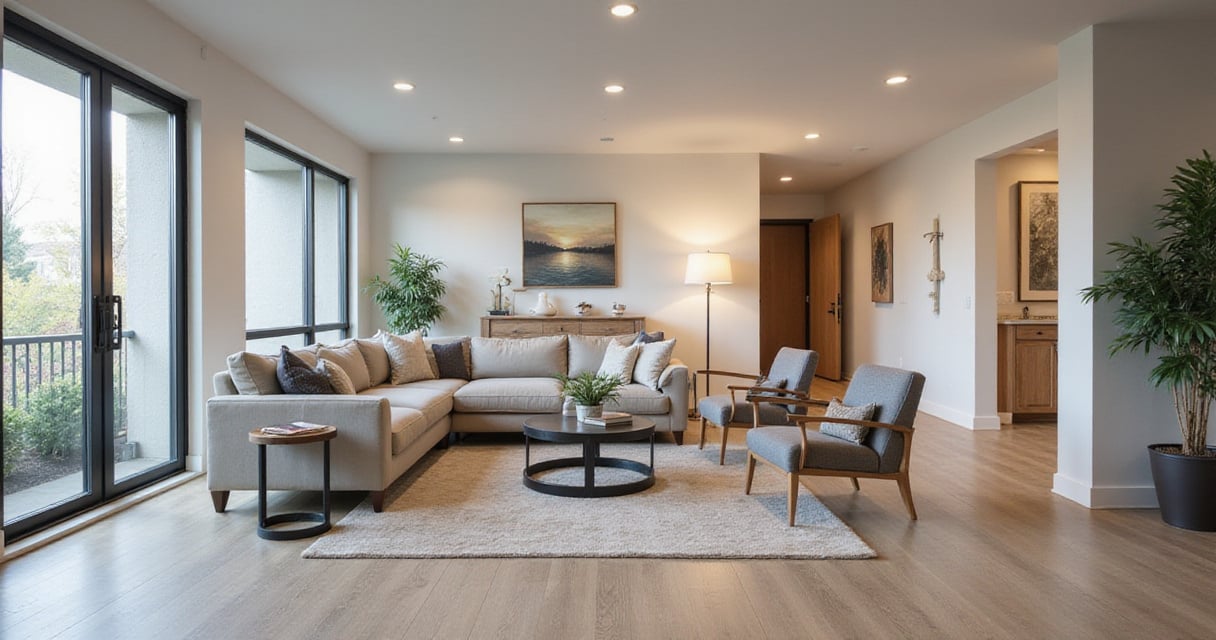
Transform your home with these 19 expert techniques for creating stunning living room interiors that balance professional display methods with comfortable, functional design for everyday life.
Your living room is more than just another space in your home—it’s the stage where life unfolds, from quiet morning coffees to lively gatherings with friends. As a retail-inspired design expert, I’ve seen how the principles that make store displays captivating can transform residential spaces into stunning living room interiors that both welcome and impress.
Whether you’re planning a complete redesign or looking to refresh your current space, the right techniques can elevate your living room from ordinary to extraordinary. I’ve compiled 19 essential approaches that blend professional display methods with practical home solutions to create living spaces that feel both curated and comfortable.
Let’s explore how to create a living room interior that showcases your style while functioning beautifully for everyday life.
The foundation of any showcase-worthy living room interior begins with a thoughtful layout that considers both purpose and focal points. Start by identifying what activities the space needs to accommodate—conversation, entertainment, reading—and what natural focal point exists, whether it’s a fireplace, a stunning view, or an entertainment center. Arrange your primary seating to relate to this focal point while maintaining conversation-friendly distances of 6-8 feet between seats. For smaller rooms, scale furniture appropriately and consider placing pieces against walls, while larger spaces can handle “floating” furniture arrangements that create distinct zones.
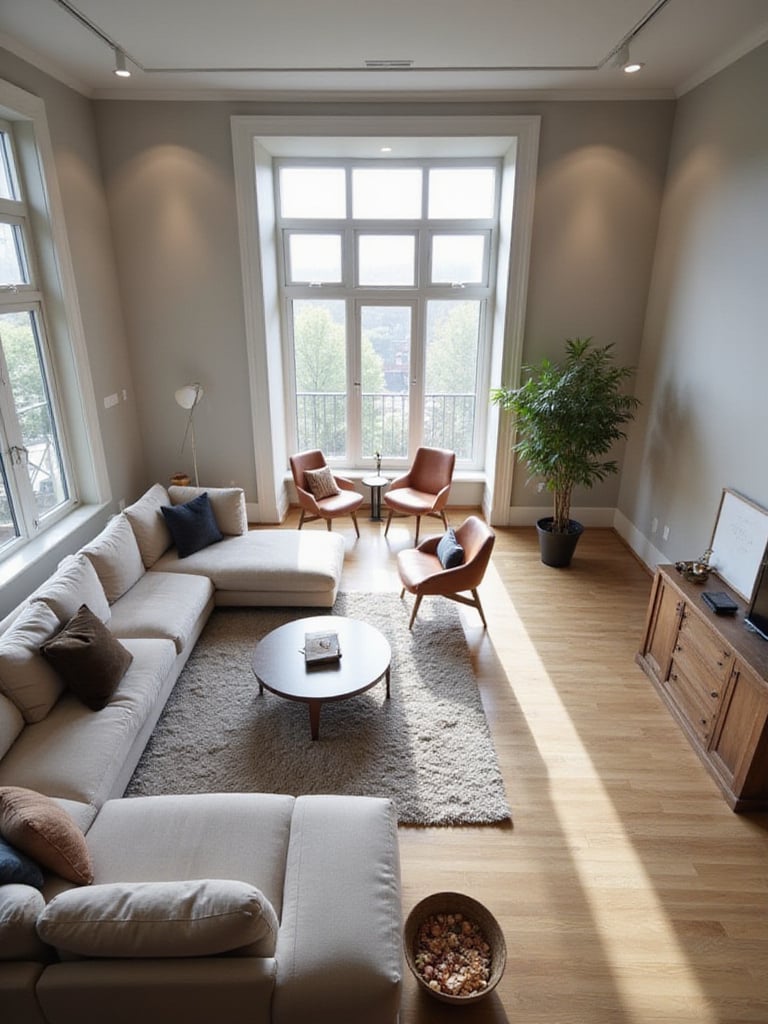
Traffic flow forms the invisible architecture of your living room interior. Clear pathways of at least 36 inches wide should connect entryways, exits, and different activity areas without obstruction. Avoid positioning large furniture pieces in main traffic lanes, and be mindful of doorways and furniture corners that might impede movement. Strategic placement of furniture backs and area rugs can subtly guide circulation around, rather than through, conversation areas.
“The most successful living room layouts feel inevitable—as though the furniture couldn’t possibly be arranged any other way—while simultaneously allowing people to move through the space with unconscious ease.”
The magic of this piece lies in its ability to serve as the foundation for everything that follows—once your layout achieves both function and flow, you’re ready to select the centerpiece that anchors the entire room: your sofa.
Determining the ideal sofa for your living room interior requires careful consideration of both size and scale. Begin by measuring your room dimensions and the specific area where the sofa will live. Use painter’s tape on the floor to visualize different sofa footprints and ensure at least 30 inches of clearance for walkways. The sofa’s scale should harmonize with your room—oversized sectionals can overwhelm smaller spaces, while petite loveseats might appear insignificant in larger rooms. Remember to measure doorways and stairwells to confirm delivery access, and consider how the sofa’s height and depth will influence the room’s proportions.
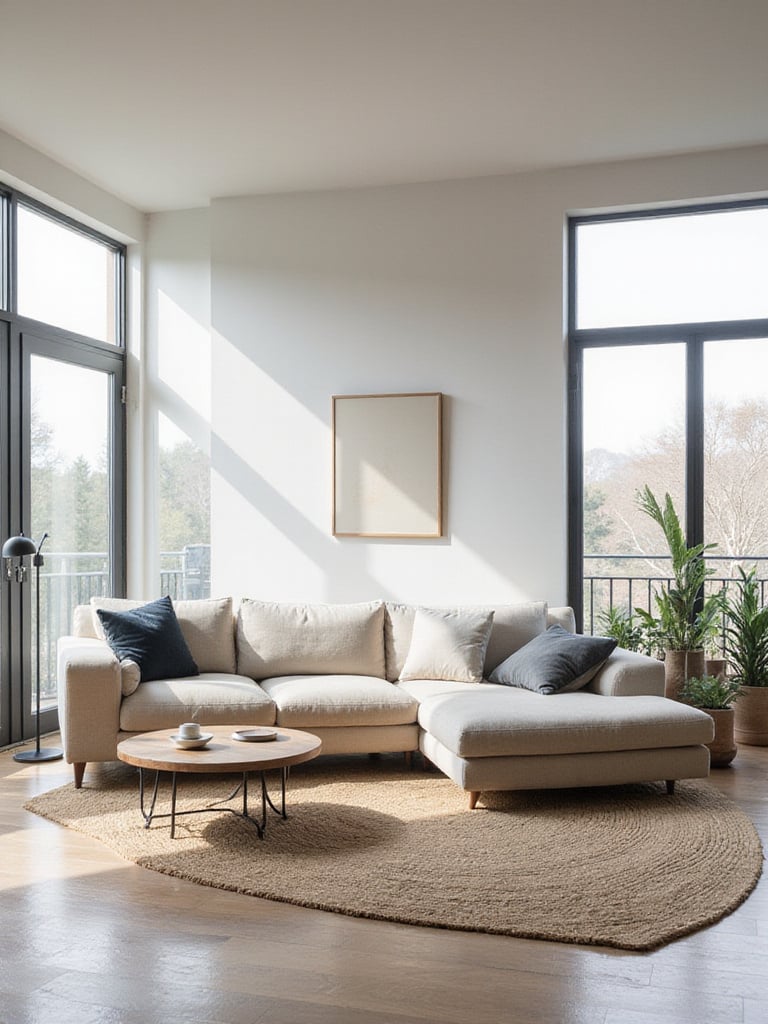
Fabric selection dramatically impacts your sofa’s durability, comfort, and aesthetic contribution. Let your lifestyle guide this decision—homes with children or pets benefit from performance fabrics, microfibers, or certain leathers that resist stains and clean easily. For luxury and comfort, velvet and chenille offer sumptuous textures but require more maintenance. Leather develops character over time and wipes clean easily but responds to temperature changes. Always request fabric swatches to examine in your actual lighting, and check the rub count for durability indicators.
The craftsmanship reveals itself in details like the frame construction, cushion fill, and joinery—all elements worth investigating before purchase. With your anchor piece selected, it’s time to consider the perfect companion that complements your sofa while adding function: the coffee table.
The interplay between the colors creates a visual relationship between your sofa and coffee table that should feel intentional and balanced. For size, aim for a table approximately two-thirds the length of your sofa, with a height within one or two inches of your sofa cushions. This proportion creates a comfortable reach while maintaining visual harmony. The scale of your room matters too—larger spaces with substantial seating can accommodate bigger, more dramatic tables, while smaller living room interiors benefit from lighter pieces, perhaps with rounded edges to improve flow.

Shape significantly influences both traffic patterns and the overall feel of your living room interior. Rectangular tables pair naturally with standard sofas, providing ample surface area for books, drinks, and decorative objects. Square tables complement sectionals or U-shaped seating arrangements. Round or oval tables excel in high-traffic areas or homes with small children, as they eliminate sharp corners and create a softer, more relaxed atmosphere. Consider how people move around your seating area when selecting a shape.
Beyond the obvious placement, consider using this for both storage and style—tables with drawers, shelves, or lift-tops provide convenient places to stash remotes and magazines, while material choices from wood to glass, metal to stone each bring different qualities to your space. With your core furniture established, it’s time to ground everything with the transformative power of the right area rug.
The unexpected environmental benefit comes from how area rugs fundamentally transform living room interiors through both visual anchoring and practical zoning. A well-chosen rug creates a cohesive “island” by placing key furniture pieces either fully or partially on its surface, defining conversation areas within larger spaces and providing structure to the room. This visual foundation pulls disparate furniture pieces together into an intentional grouping rather than scattered elements, giving the space a sense of purpose and intimacy.

Beyond its organizational function, an area rug serves as a powerful design element that injects personality, color, and texture into your living room interior. It can introduce bold patterns to minimalist spaces, add warmth through rich colors, or layer texture with materials ranging from plush wool to natural jute. Many designers start with a statement rug to establish the room’s color palette, using it to inform paint choices, upholstery fabrics, and accessories. From a sensory perspective, rugs add softness underfoot, absorb sound to improve acoustics, and create a more inviting atmosphere.
The styling mistake most people make is selecting a rug that’s too small, which creates a disconnected, floating furniture arrangement. With your foundation elements in place, it’s time to consider how light shapes the entire living room experience.
While clients ask us about balancing style with comfort, lighting consistently emerges as the element that can make or break a living room interior. Successful lighting design involves three essential layers: ambient, task, and accent lighting. Ambient lighting provides overall illumination through ceiling fixtures like chandeliers, recessed lights, or large floor lamps, establishing the room’s basic brightness. Task lighting focuses on specific activities—reading lamps beside chairs, table lamps on side tables—preventing eye strain during focused activities. Accent lighting highlights architectural features, artwork, or decorative elements through picture lights, wall sconces, or uplighting, adding depth and drama.
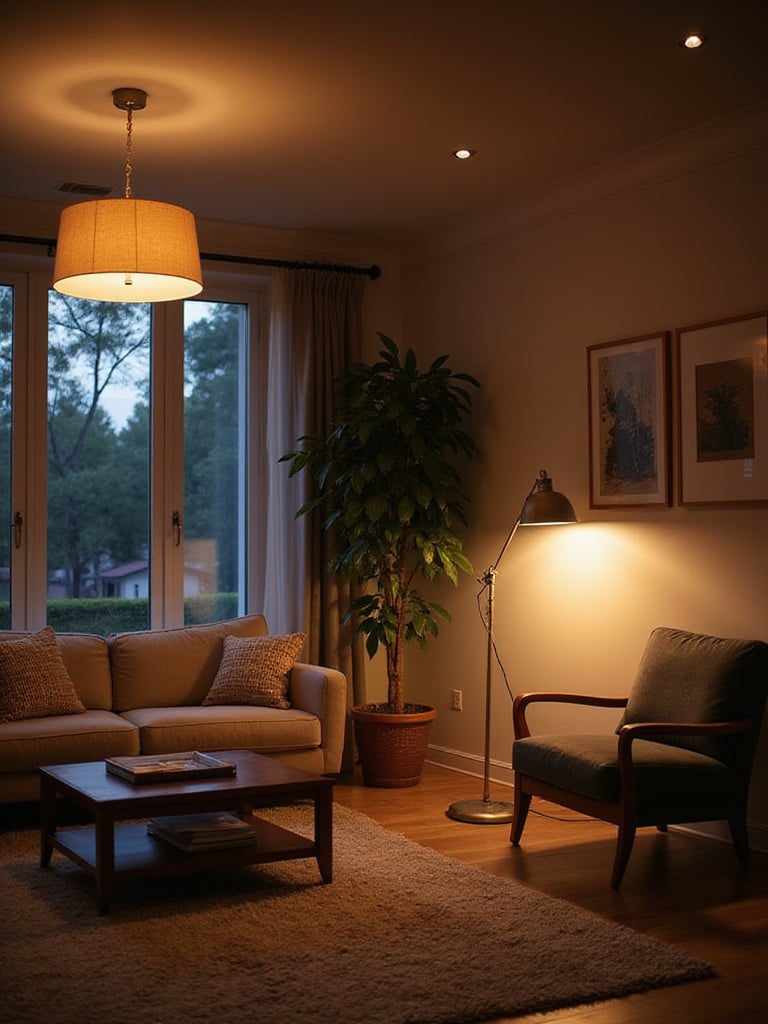
This layered approach transforms a living room interior from a flatly lit space into a dynamic, inviting environment with dimension and character. Relying solely on overhead lighting creates harsh shadows and a sterile feeling, while layering creates depth, warmth, and flexibility. The interplay between different light sources adds sophistication and allows you to adjust the atmosphere for various activities and times of day. When paired with dimmers, layered lighting offers remarkable versatility, transitioning from bright and functional to soft and intimate with simple adjustments.
“Light is the magical ingredient that makes or breaks a space; it’s one of the most important elements in all my interiors. Without proper lighting, every decision you’ve made about color, texture, and arrangement loses its impact.”
The ambiance evolves throughout the day as natural light changes, making it essential to consider how your artificial lighting complements these shifts. With your lighting plan established, it’s time to select a color palette that will set the mood for your entire living room interior.
The revival of this classic form comes with a twist in how we approach color selection for living room interiors today. Color choices profoundly influence the psychological experience of your space—they can make a room feel warm and cozy, bright and energetic, or calm and serene. A thoughtfully chosen palette creates visual harmony by connecting furniture, decor, and architectural elements into a cohesive whole. Without this unifying element, even beautifully selected pieces can feel disjointed or chaotic.
![Living room interior featuring a harmonious color palette with neutral walls, [Secondary Color] furniture, and [Accent Color] accents.](https://decorfrontier.com/wp-content/uploads/2025/05/Finding-Your-Ideal-Color-Palette-682bf898ab796.png)
The 60-30-10 rule offers a helpful framework for balancing colors: approximately 60% should be your dominant color (walls, large furniture), 30% your secondary color (curtains, accent chairs, rugs), and 10% your accent color (accessories, artwork). Understanding color relationships enhances your palette—analogous colors (adjacent on the color wheel) create harmony, complementary colors (opposite each other) generate energy through contrast, and monochromatic schemes using variations of one color produce sophisticated serenity. Consider undertones carefully; even neutrals have warm or cool bases that affect how colors interact.
The unexpected color story emerging this year shows how living room interiors are becoming more personalized and expressive. With your palette established, it’s time to consider how to elevate your walls with art and mirrors that complement your color choices.
The designer’s attention to detail shows in how thoughtfully placed art and mirrors can transform living room interiors from basic to breathtaking. Art infuses personality and narrative, reflecting your tastes and experiences while introducing color, pattern, and visual interest. It establishes mood, creates focal points, and ties together your color scheme. Mirrors, meanwhile, serve as powerful tools for manipulating light and spatial perception. They reflect natural and artificial light, making rooms feel brighter and more expansive, while bouncing light into darker corners and creating the illusion of depth.
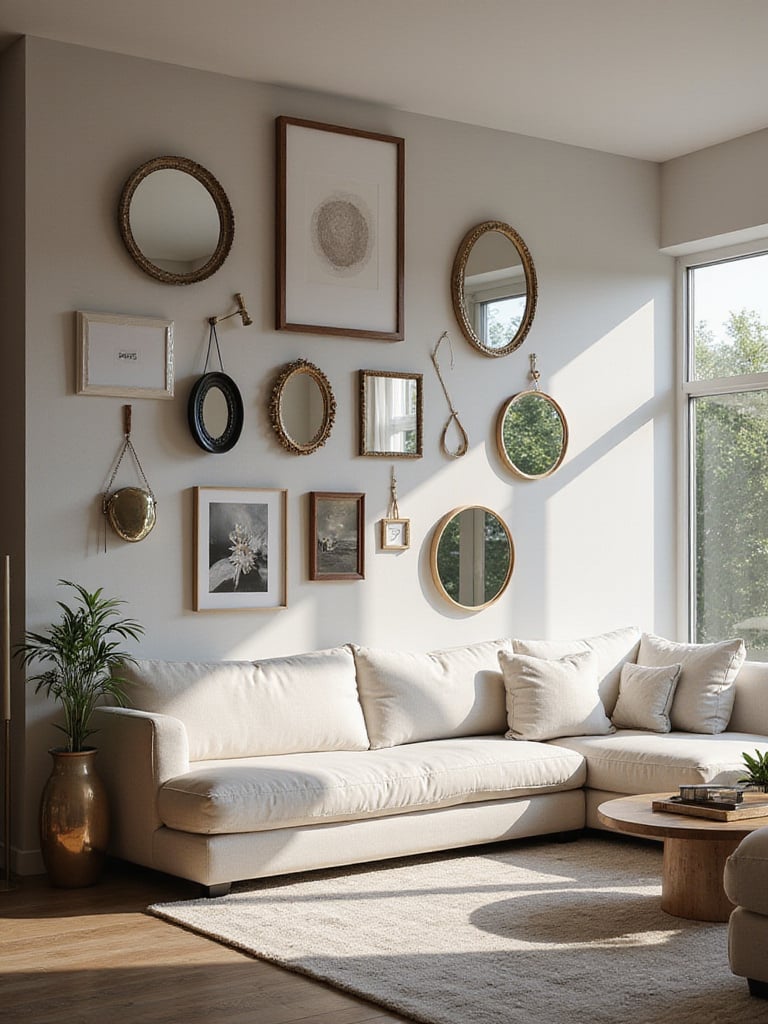
Selection and placement require careful consideration for maximum impact in your living room interior. Choose art that resonates personally or complements your existing palette, paying attention to scale—a single large piece can anchor a wall powerfully, while smaller works create interest through grouping. For mirrors, determine whether your goal is primarily decorative (ornate frames, unusual shapes) or functional (maximizing light, creating depth). Hang art at eye level, generally 57-60 inches from floor to center, and position mirrors opposite windows or light sources to maximize their brightening effect. For gallery walls, arrange pieces on the floor first or create paper templates to plan the layout before committing.
If you’ve struggled with similar rooms before, you’ll find that these vertical elements create crucial visual interest at eye level, drawing attention upward and making the entire living room interior feel more designed. As we elevate the walls, let’s not forget another vertical element that frames your space: window treatments.
The artisans behind these designs began with the understanding that window treatments are not merely functional elements but crucial framing devices for your living room interior. Like a mat and frame around artwork, they effectively showcase the view beyond while integrating the window into your overall design. Drapery panels hung wide of the window frame create grandeur and emphasize the glass expanse when open. Valances or cornices add architectural interest, while side panels define vertical edges. The texture, color, and style of your chosen treatments contribute to how the view is presented, enhancing its visual impact within your living room aesthetic.
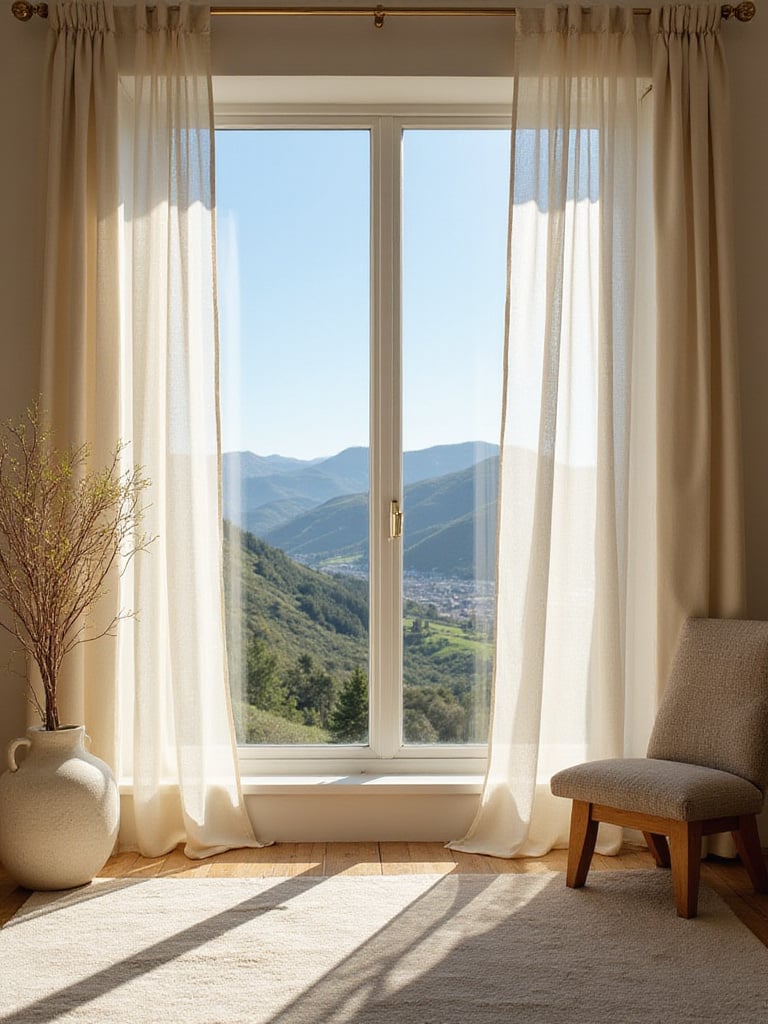
When your space features desirable views, selecting treatments that preserve visibility while offering necessary functionality becomes essential. Sheer curtains or light-filtering shades provide daytime privacy while maintaining a soft connection to the outdoors. Side-hung drapery panels that stack neatly off the window when open frame views beautifully without obstruction. Roman shades or cellular blinds can be fully raised, leaving the entire glass area clear when desired. For maximum view preservation with optional privacy, consider treatments that disappear almost entirely when open, such as roller shades or shutters with adjustable louvers.
The challenge of awkward spaces becomes easier when you understand how window treatments can visually correct proportion issues in your living room interior. With windows properly dressed, let’s address another common challenge: managing clutter through smart storage solutions.
Many homeowners wonder how to maintain a showcase-worthy living room interior while accommodating the realities of daily life. Smart storage solutions are essential because they combat clutter—the greatest enemy of beautiful design. By effectively organizing and concealing everyday items like remotes, books, games, and electronics, thoughtful storage creates order and tranquility, allowing your carefully chosen aesthetic elements to shine without competition from life’s necessities. Well-integrated storage becomes part of the design itself, adding architectural interest and style while serving crucial practical functions.
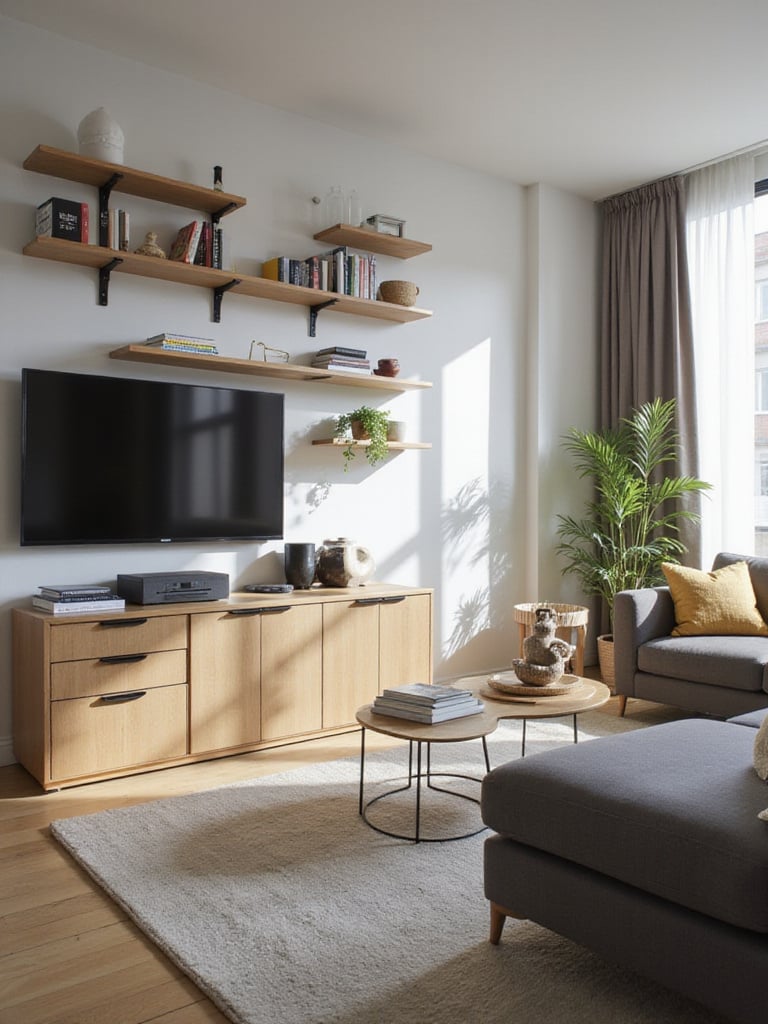
Creative integration means viewing storage as a design element rather than merely functional. Consider multi-purpose furniture like ottomans with hidden compartments, coffee tables with drawers, or sofas with under-seat storage. Built-in shelving around architectural features adds significant interest while maximizing space efficiency. Vertical storage solutions draw the eye upward, making rooms feel larger. Decorative boxes, stylish baskets, and vintage trunks hide items in plain sight while contributing texture and personality to your living room interior. Even media consoles can be selected for sophisticated design and integrated cable management, seamlessly blending technology into your aesthetic.
When your existing decor doesn’t seem to coordinate, storage pieces can actually help create cohesion through consistent finishes or complementary styles. With clutter managed, it’s time to add layers of comfort and personality through textiles.
The material sourcing makes all the difference in how decorative pillows and throws transform living room interiors from basic to luxurious. These versatile accessories serve dual purposes: enhancing both comfort and aesthetics. Visually, they introduce color, pattern, and texture, breaking up large furniture surfaces and adding interest. They can tie together existing color schemes, introduce accent colors, or add personality through varied patterns from bold geometrics to subtle weaves. From a comfort perspective, they provide literal softness, support, and warmth, making seating areas more inviting for extended relaxation.

Selecting and arranging these textiles effectively requires balancing color, texture, pattern, and scale. Consider your living room interior’s existing palette and desired mood, choosing pieces that either complement or purposefully contrast with your furniture. Mix textures—velvet, linen, knit, faux fur—to create depth and tactile interest. When incorporating patterns, vary the scale by combining larger designs with smaller prints and solid textures. Layer pillows from larger at the back to smaller in front, and drape throws either casually for relaxed spaces or fold them neatly for more tailored environments. Aim for odd numbers of pillows for a natural look, adjusting quantity based on furniture size.
The unexpected pairing that always works is combining structured, tailored upholstery with casual, textural throws and pillows for balanced contrast in your living room interior. While textiles add softness, nothing brings energy and life to a space quite like the addition of plants.
The environmental story behind this piece began with the recognition that plants contribute far more than mere decoration to living room interiors. They actively improve air quality by absorbing carbon dioxide, releasing oxygen, and filtering common indoor pollutants like formaldehyde and benzene. Research shows they boost mood, reduce stress, and improve concentration, creating a more calming and productive atmosphere. Their organic shapes and varying shades of green add natural texture and color that soften architectural lines and make spaces feel more welcoming and connected to nature. They also help regulate humidity and can even reduce ambient noise.

Selecting appropriate plants requires assessing your living room interior’s specific conditions. Observe the natural light patterns—whether your space receives bright indirect light, direct sun, or limited light—and choose species known to thrive in those conditions. Consider available space; dramatic floor plants make statement pieces in corners, while smaller varieties add touches of green to shelves and tables. Be realistic about your commitment to plant care; forgiving options like Snake Plants, ZZ Plants, and Pothos survive occasional neglect, while others demand more attention. Think about the aesthetic you want to achieve—lush tropical foliage, architectural succulents, or flowering varieties all create different effects.
The craftsmanship becomes evident after years of use when you notice how plants grow and change with your space, becoming living elements of your design that evolve over time. While plants add natural life, it’s the personal touches that truly make a living room interior feel like home.
As morning light filters through, the texture creates a different experience with each thoughtfully selected accessory in your living room interior. The most meaningful items for showcasing personality are those carrying personal significance—framed photographs of cherished moments, artwork collected over time (not just pieces matching the sofa), travel souvenirs, family heirlooms, personal collections, and handmade objects. These authentic elements transform generic spaces into uniquely yours, offering glimpses into your life, passions, and heritage that mass-produced decor simply cannot provide.
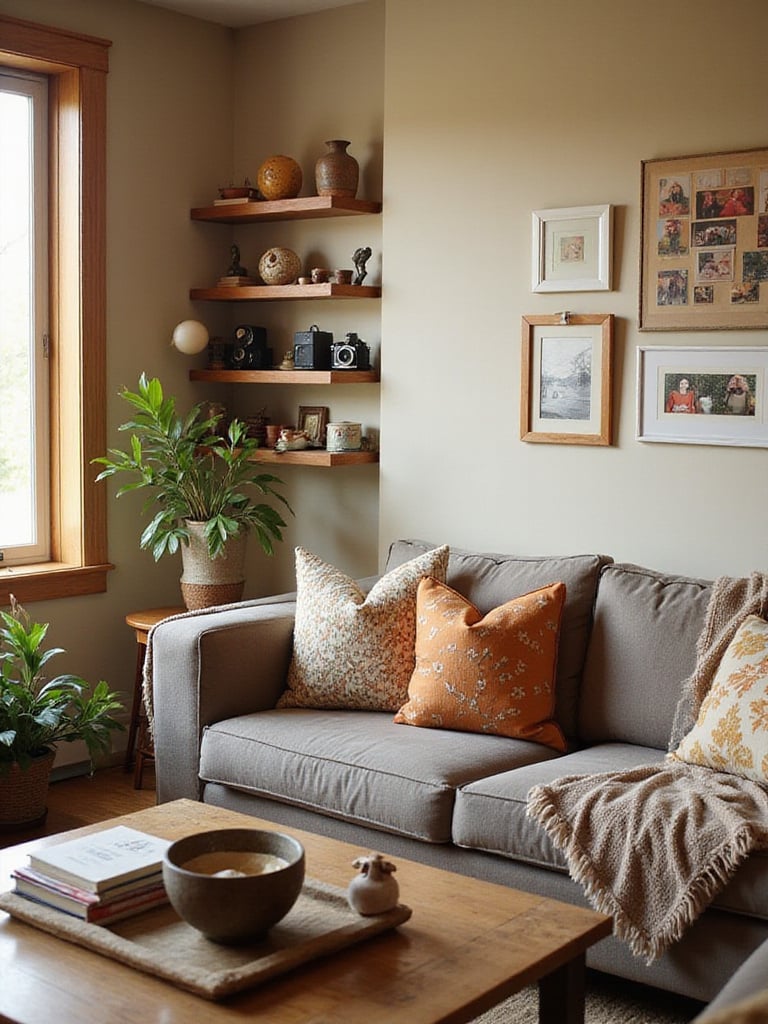
Incorporating these personal touches without creating clutter requires strategic curation and placement. Group similar items together in intentional displays rather than scattering them randomly—collections on a single shelf, photos arranged as a gallery. Use decorative trays or bowls to contain smaller objects on tables, providing visual boundaries. Vary heights, shapes, and textures within groupings to create visual interest. Leave some surfaces empty as visual resting places, preventing the living room interior from feeling overwhelmed. Regularly edit your displays, rotating items seasonally to keep the space fresh and reflective of your evolving story.
The emotional response this evokes begins with recognition that truly personal living room interiors feel inherently more welcoming and interesting than perfectly styled but soulless spaces. With personality woven throughout, establishing a strong focal point will give the room clear direction.
The silhouette draws inspiration from how focal points have long served as anchoring elements in successful living room interiors. A focal point acts as the visual center of gravity—the dominant element that immediately captures attention upon entering the space. It provides a starting point for furniture arrangement and decorating decisions, contributing to a cohesive, balanced design. Without this visual anchor, rooms can feel disjointed or directionless, with the eye unsure where to rest. A well-defined focal point guides viewers through the space, creating order and intentionality.
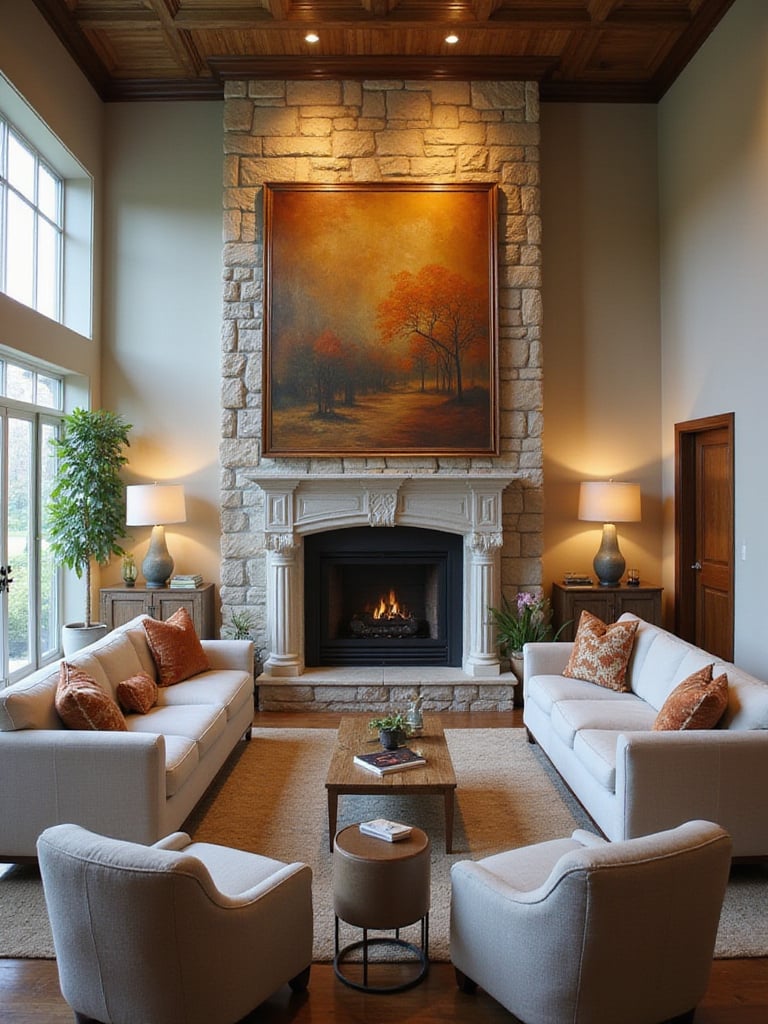
Existing architectural features often serve as natural focal points—fireplaces, large windows with striking views, or built-in shelving units. However, you can also introduce focal points through design choices. Consider a large, impactful piece of art, a dramatic accent wall in bold color or statement wallpaper, a unique furniture piece, or even a strategically placed plant grouping. To enhance existing focal points, add thoughtful styling elements—artwork above a fireplace, dramatic lighting, or complementary furniture groupings. For created focal points, ensure they have sufficient visual weight to anchor the room and arrange other elements to support rather than compete with them.
Running your hand across this material reveals how a strong focal point draws you in and creates a sense of purpose in your living room interior. Once established, ensuring smooth movement around this center becomes crucial for functionality.
The journey of this sustainable material involves understanding how people naturally move through spaces—a concept essential to living room interior design. Traffic flow refers to the pathways people take when navigating a room, including movement between entry points, exits, and key areas like seating arrangements or focal points. Ensuring these paths remain clear, logical, and unobstructed allows comfortable, efficient movement without awkward squeezing or furniture obstacles. Consider how someone enters your living room and where they naturally need to go next—is that path intuitive and open?

Poor traffic flow can make even beautifully furnished living room interiors feel awkward and frustrating to use. Functionally, it interrupts conversations, increases trip hazards, and makes spaces feel smaller and more cluttered than they actually are. Aesthetically, rooms with good flow feel inherently more open, welcoming, and harmonious. They allow design elements to be appreciated without the distraction of uncomfortable navigation, contributing significantly to the overall appeal of the space. When flow works well, it creates an almost unconscious sense of ease that enhances the entire experience of the room.
The interplay between the colors creates visual pathways that complement physical ones, guiding the eye just as furniture placement guides the body. With movement addressed, understanding scale and proportion ensures everything fits together harmoniously.
After months of sourcing and curation, I’ve found that understanding scale and proportion is fundamental to creating balanced living room interiors. Scale refers to an object’s size relative to the room itself—a massive sectional might overwhelm a small space, while a petite loveseat could look insignificant in a large room. Proportion concerns how objects relate to each other within that space—ensuring a coffee table is appropriately sized for the sofa it accompanies, or that artwork isn’t dwarfed by the wall it hangs on. While often used interchangeably, scale connects objects to the room, while proportion addresses relationships between the objects themselves.

Getting these relationships right is crucial for both aesthetics and comfort in your living room interior. When scale is off, furniture either dominates the space, creating cramped, difficult-to-navigate conditions, or feels lost and insignificant, making rooms seem empty and uninviting. Poor proportion creates visual imbalance—imagine a tiny coffee table beside a massive sofa, or numerous small pieces scattered without anchoring elements. Correct scale and proportion ensure furniture fits comfortably, allows easy movement, creates visual harmony, and makes the room feel intentionally designed rather than randomly assembled.
What separates artisanal quality from mass-produced is attention to these fundamental relationships that make a space feel “right” even if the viewer can’t articulate why. While scale addresses size relationships, the tactile experience changes when you add texture variations.
The sustainable journey of this material involves understanding how texture transforms living room interiors from flat and one-dimensional to rich and layered. Texture adds crucial visual complexity and tactile interest, engaging multiple senses and preventing spaces from feeling sterile or monotonous. Different textures highlight various elements, create appealing contrast, and help define zones within the room. The interplay between smooth leather, chunky knits, rough jute, and shiny metals creates a dynamic environment that invites both visual exploration and physical touch.
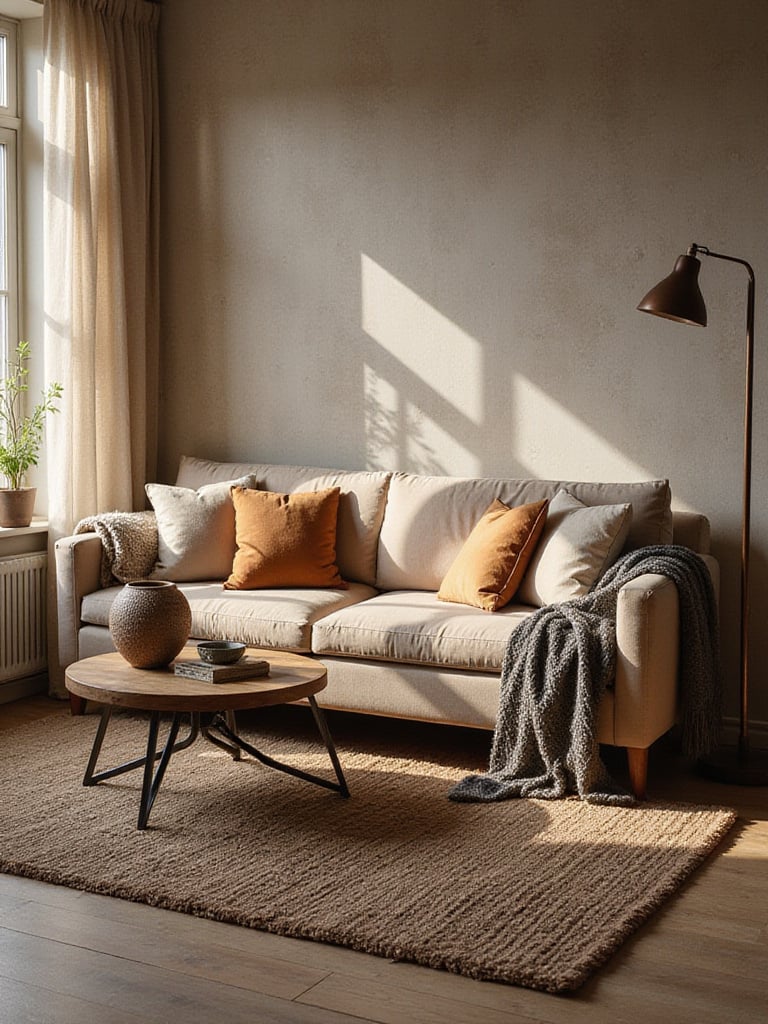
To mix textures effectively without creating chaos, maintain balance through a unifying element like a consistent color palette. This provides a calm backdrop that allows textures to stand out without competing. Distribute varied textures throughout the living room interior rather than concentrating them in one area, seeking contrasts that create interest—smooth with rough, matte with glossy, soft with hard. Layering is essential—combine different textiles on upholstery, mix materials in furniture pieces, and incorporate varied surfaces in accessories. Ensure there are visual “rest areas” where textures are simpler to prevent overwhelming the eye.
The quality becomes evident after years of use when textural elements develop patina and character that flat, uniform surfaces cannot achieve. With texture adding sensory richness, organizing your living room interior into functional zones enhances its usability.
We’ve been working behind the scenes on something special: the art of zone definition that transforms living room interiors from undefined boxes into purposeful, multi-functional spaces. Creating distinct zones is particularly important in open-plan layouts or rooms serving multiple purposes, breaking large areas into intimate, manageable sections tailored to specific activities like conversation, reading, working, or entertainment. This organization prevents rooms from feeling cluttered or undefined, ensuring every square foot serves a purpose. Psychologically, well-defined zones create a sense of order and intention, making spaces feel more comfortable and efficient.
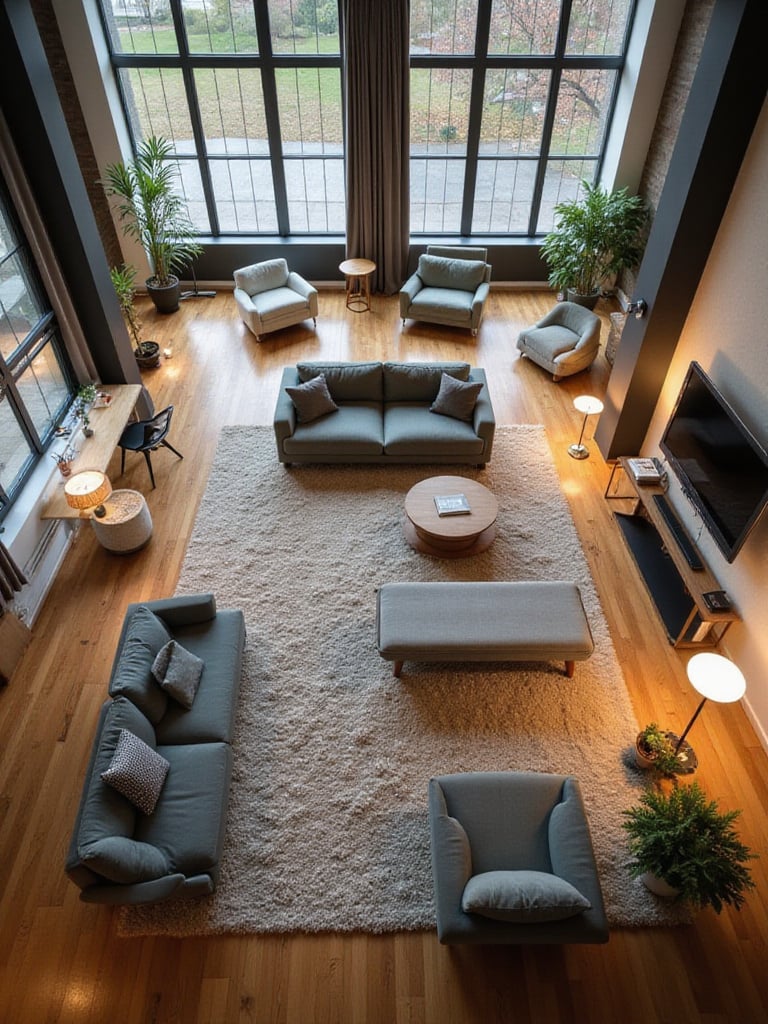
Common living room interior zones typically include the main conversation area centered around primary seating and a coffee table, designed for social interaction. Entertainment zones focus on media consumption with appropriate seating and viewing angles. Reading nooks feature comfortable chairs, good lighting, and surfaces for books or drinks. Work stations provide discreet spots for household management or remote work. In open-plan spaces, dining areas or bar seating might create casual eating spots. For families, designated play areas with appropriate storage keep toys contained while allowing supervision from adult zones.
The maker’s journey from apprentice to master influenced how we understand the importance of purpose-driven design in living spaces. With zones established, integrating technology seamlessly ensures modern functionality doesn’t detract from aesthetics.
Look closely and you’ll notice the subtle texture of thoughtfully integrated technology in today’s living room interiors. Unsightly cables and wires can quickly undermine even the most carefully designed spaces, creating visual clutter and a sense of disorder. Several effective solutions exist: for wall-mounted TVs, consider recessed outlets behind the television with cables running through the wall cavity (consulting professionals as needed). Alternatively, use paintable cable raceways that blend with wall colors. For media consoles, select furniture with built-in cable management or use sleeves and ties to bundle wires neatly. Strategic furniture placement can also help conceal necessary connections.
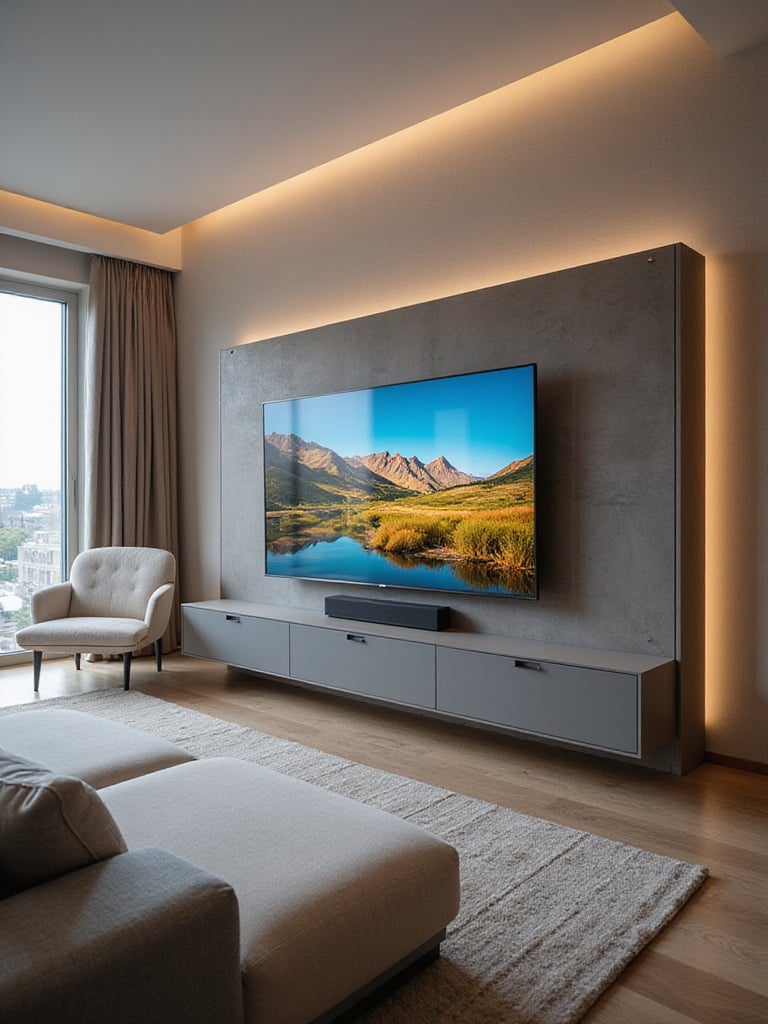
Large black television screens often dominate walls when not in use, creating visual imbalance in living room interiors. Minimize their impact by selecting TVs with “Art Mode” that display artwork or photos when not in active use. Frame the television with custom millwork or decorative molding to integrate it into the wall design. Recessing the TV into a wall niche or incorporating it into built-in shelving helps it blend with the architecture. For dedicated media rooms or minimalist aesthetics, consider projectors with retractable screens that disappear completely when not needed.
The traditional methods used result in living room interiors where technology enhances rather than detracts from the overall aesthetic. With practical elements addressed, discovering your signature style brings everything together into a cohesive expression.
The inspiration for this collection struck when I realized that the most compelling living room interiors reflect their owners’ unique personalities rather than following rigid style categories. Your signature style goes beyond labels like “modern” or “traditional”—it’s your personal interpretation and combination of elements that create a space reflecting your tastes, lifestyle, and aspirations. A living room that embodies your signature style feels inherently more comfortable and fulfilling because it tells your story and creates an intentional atmosphere rather than simply assembling random pieces.

Identifying your design preferences requires both introspection and exploration. Look for inspiration beyond interiors—consider your fashion choices, favorite art, travel destinations, and hobbies. Create a mood board collecting images of rooms, furniture, colors, and objects you’re drawn to without overthinking whether they “match.” Analyze for patterns: Do you consistently save images with clean lines and minimal décor, or are you attracted to layered textures and global influences? Do you prefer bright, airy spaces or cozy, intimate ones? Examine your existing possessions—which pieces do you truly love and why? Consider how you actually use your living room interior and how you want it to feel. Once patterns emerge, you can name your style (“refined industrial,” “coastal bohemian”) and use this as a guiding principle for future decisions.
The cultural heritage preserved in each piece includes your own history and preferences, making your living room interior uniquely yours. Mixing different styles is not only acceptable but often creates the most interesting and authentic spaces. The key is finding common threads—consistent color palettes, similar materials, shared formality levels, or thematic connections—that create harmony amid diversity.
Creating a showcase-worthy living room interior isn’t about following rigid rules or chasing fleeting trends—it’s about thoughtfully applying professional display techniques to craft a space that feels both curated and comfortable. By mastering fundamentals like layout, scale, and flow while incorporating personal elements that tell your unique story, you can transform your living room into a space that impresses visitors and welcomes you home every day.
Remember that the most successful living room interiors balance visual impact with practical function. They showcase your style while accommodating real life. They feel designed without feeling untouchable. Whether you’re starting from scratch or refreshing your current space, these 19 techniques provide a framework for creating a living room that’s not just beautiful, but beautifully livable.
Your living room is where your home’s story unfolds—make it a space worth showcasing.